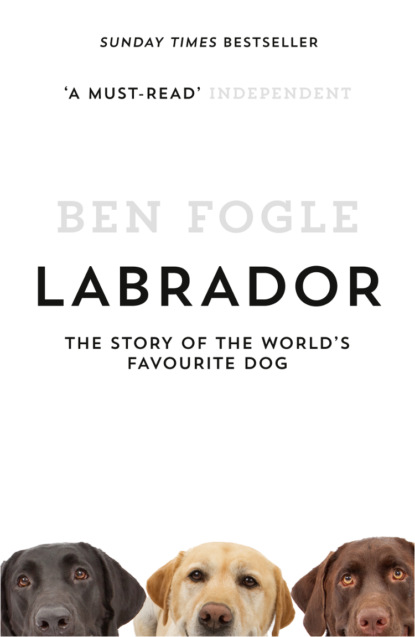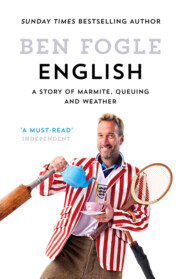По всем вопросам обращайтесь на: info@litportal.ru
(©) 2003-2024.
✖
Labrador: The Story of the World’s Favourite Dog
Настройки чтения
Размер шрифта
Высота строк
Поля
As we pulled away from the yard, I caught a glimpse of her sad, dark eyes. Why was I turning my back on this lone pup? Suddenly I wasn’t sure, but as with love, I wanted to be certain. How would I know she was the one?
For the next few days I couldn’t stop thinking about her. It had been more than a week and I was certain she’d be gone.
‘She’s still here,’ said the woman down the phone.
I raced back. We pulled up to the house and were led into the living room, where the puppy was alone. She had been weaned from her mother, which meant separating the dogs. Immediately she ran up to me and licked my face. The swelling on her eye had subsided and, away from her greedy siblings, she was now much rounder, with a bulging pink belly.
She gazed up at me with her hazel eyes as I ran my fingers through her thick black hair. I nuzzled my nose behind her ear and inhaled her scent. It was instant love. I had always been told that I’d find her, and now I really had found ‘the one’. I named her Inca.
I held her close as we walked out into the crisp winter night, but as we approached the car I heard a commotion in the background.
‘Get back here!’ cried a voice.
The puppy’s mother had broken free and came bounding over. She jumped up and licked Inca clean across the face, then lifted her ear. I am not one to over-anthropomorphise our animals, but I swear she was wishing her luck. She was whispering something into that little dog’s ear, and I’d like to think she was telling her to look after me.
As quickly as she had appeared, Inca’s mother vanished back into the darkness. Her owner looked on in astonishment, a tear in her eye.
And so began a friendship that would change things forever. Little did I realise then how much this little dog would form, shape and create my life. She would change it in ways I never thought possible. The story of Inca is, ultimately, the story of me.
Inca and I became inseparable. I was still living in my childhood bedroom in my parents’ house, and I can vividly remember setting up her little crate at the foot of my bed, feeling both fear and excitement at the journey that lay ahead.
My life of blissful selfishness was over and a new one of selflessness was beginning. I genuinely think that those two words separate dog owners from non-dog owners.
I guess, on the face of it, it is a little strange that we invite this hairy animal into our homes. We share our lives with a creature that was once undomesticated and wild. I’ve always been fascinated as to why we keep dogs. Why we love dogs. Why we mourn our dogs when they go. Of course, it varies from culture to culture and from country to country. Some argue it is a sign of development; the more developed a country the higher the number of pet dogs. The sharp spike in the number of pet dogs in China, with its emerging middle-class population, seems to back that up.
By the very late nineteenth century in Britain, the popularity of the Labrador was on the rise and it wasn’t long before the Royals got in on the act, in a connection with the breed that has endured right up to the present day.
The first Labrador kennels were established at Sandringham by King Edward VII, then Prince of Wales, in 1879 to house a hundred dogs, and the Sandringham kennels and the Labradors that are bred there have become firm favourites of the Royal Family as a whole. In fact, it may come as a surprise to many that the Queen is as fond of her Labradors as she is of her infamous Corgis.
In many ways the Corgis are the public face of the Queen’s canine companions, but the Labrador is the private love of her life. I was once told a story that the Queen has several Land Rovers custom-made with windscreen wipers on the inside. Apparently these were specifically adapted for her Labradors, who have a tendency to steam cars up from the inside out.
The Queen takes a very great interest in the Sandringham kennels. Since her accession to the throne in 1952, the breeding programme there has gone from strength to strength, culminating in the training of five Field Trial Champions. All the puppies born at Sandringham are named personally by the Queen and are registered at the Kennel Club with the prefix Sandringham.
At any one time, the kennels are home to about 20 dogs of all ages, including Labradors and Cocker Spaniels – ranging from the older and more experienced gundogs used by members of the Royal Family during the shooting season to the younger dogs under training as gundogs.
In addition to providing dogs for the Royal Family, the kennels also supply the Estate gamekeepers with working Labradors and Spaniels.
In a bout of hopeful optimism I sent a note to Her Majesty’s equerry asking if it would be possible to visit the Queen’s Labrador kennels at Sandringham. I was politely informed that the kennels are extremely private and that a visit would be impossible. While the Corgis are frequently photographed at the Queen’s side, her Labradors are rarely seen and it appeared that was the way she wanted it to remain.
Records of the breed were kept by the Buccleuch estate in Scotland at around the same time that Edward VII was beginning his Labrador breeding programme, and it is these that note the arrival of two chocolate puppies or ‘liver pups’ in 1890. Could these have been the progenitors for the future of chocolate Labradors? The royal household would undoubtedly have given the liver pups the ultimate royal seal of approval.
But while the Labrador was finally establishing itself on our shores, across the Atlantic a problem was looming that threatened the strength and integrity of the breed in Britain. In 1885 the Newfoundland government, worried about the number of dogs in the region, passed the Sheep Protection Act which gave local government the right to impose a dog licensing tax as well as the right to prohibit dogs completely.
Inevitably, dog importations were affected. Colonel Peter Hawker wrote in the Instructions to Young Sportsmen that, ‘Poole was, till of late years, known to be the best place to buy Newfoundland dogs; either just imported or broken in; until they became more scarce, owing (the sailors observe) to the strictness of those tax gatherers.’
The 1885 Act was meant to encourage sheep raising by reducing the number of potential predators, but the result was to kill the Labrador export trade. The Quarantine Act of 1895 created another barrier to the importing of dogs. The Act prohibited dogs from entering Great Britain without a licence and without first undergoing a strict six-month quarantine to prevent the introduction of rabies.
The future of the Labrador hung in the balance.
Between 1890 and 1930 the multiple taxes, restrictions and paperwork meant no new dogs were imported to Britain and the results were quickly felt. This was the moment when ‘breed mixing’ began. Some breeders began mixing Labradors with Setters and Pointers. ‘Bearing in mind the high qualities attributed to pure Labradors, it is somewhat strange that the breed should have been allowed to degenerate by the various crosses of Setter and Spaniel blood,’ wrote Hugh Dalziel in his 1897 publication, British Dogs, Volume III,referring to new problems such as a hard mouth and sulky temper.
Within the tight circle of enthusiasts there was a move to preserve the purity of the breed. In 1903 the Labrador Retriever was recognised by the Kennel Club. In 1904, it was granted breed status and listed separately as a member of the Gundog Group. The breed standard was written, and it was almost identical to the one that holds sway today.
During the first decade of the twentieth century, Labrador Retrievers rose to prominence in the show ring and in field trials, and were also much favoured gundogs. By 1913, they were so well entrenched in the world of dog ownership that their qualities as working dogs were causing an emotive debate. The criticism that was voiced that they could be a ‘bit hard in the mouth’ was queried by Frank Townend Barton in his authoritative volume, Gun Dogs. The ideal retriever is a ‘soft-mouthed’ dog, a fetcher which picks up game softly but firmly to bring back birds that are fit for the table. Dogs that unnecessarily drop, crunch on, chew or even eat the bird before delivery to the handler are considered ‘hard-mouthed’.
‘If the Labrador possesses the qualities assigned to it by James Craw (at one time gamekeeper at Hirsel and Netherby), viz sagacity, stamina, perseverance, quickness and nose, then no other variety can come up to the Labradors,’ he wrote. ‘The only fault that he had to find with some of them – a fault common to all other varieties of retriever – was that they were a bit hard in the mouth. Gamekeepers and shooting men required a dog that could retrieve birds and game without piercing the skin with their teeth. I have always thought Labradors have one of the softest of bites; indeed, I have even seen Labradors carry fresh, unboiled eggs in their mouths while running.
Controversy, however, has frequently arisen concerning this matter, but supporters often point out that this trait spans the retriever group as a whole. Sometimes hunger just takes over.
Townend Barton reasoned ‘the Labrador was one of the best dogs in existence for a gamekeeper, most of which like their dogs to look ‘well and fit’ at the opening of the shooting season, without needing to devote much attention to them during the busy time, which necessarily precedes it on estates where hand-rearing of pheasants is carried on to any extent.’
Barton gives his ‘strong recommendation of the breed to shooting men’ on the eve of the First World War. The sixth Earl of Malmesbury recalls the estate keeper, Mr Beech, being called up into the Royal Artillery and ‘… the [Labrador] bitch he left behind pined so much that she sadly died. As a child I just remember her. She was the last of the direct descendants of the dogs imported in 1823.’
In the middle of the war, in 1916, the Labrador Retriever Club was founded by Lord Knutsford (then the Honourable Arthur Holland-Hibbert) and Lady Howe (then Mrs Quintin Dick), with a Mr T. W. Twyford of Staffordshire, to champion the breed, and Labs suddenly became the fashion. In 1916 the club authored the first Labrador Retriever standard. In the 1920s and 30s, King George VI and Queen Elizabeth promoted Labradors at shows through their kennel, and the King entered dogs in Crufts. In 1938, King George became Patron of the Labrador Retriever Club. In 1952, on the death of George VI, Queen Elizabeth the Queen Mother continued as patron. Today, the Her Majesty the Queen is Patron of the Club and the Duke of Wellington is President.
The Hon Henry Holland-Hibbert, great grandson of the 3rd Viscount Knutsford, still has the stud book that traces the foundation of the famous Munden line of Labradors and, according to records, the original kennel is still intact on the Munden Estate.
It’s strange how trails can lead you in circles. I had already traversed the Atlantic Ocean in an effort to understand more about the breed I love so much, and now I found myself navigating the North Circular around west London towards Munden House, a 30-room eighteenth-century mansion located in the suburbs of London, just off the M1. The seat of the Viscount Knutsfords since 1874, the estate is an oasis of rural calm in the embrace of one of the most urbanised parts of the United Kingdom. There is no great gatehouse, pomp or ceremony; a tiny gate leads the way through barley fields to the manor house.
Henry Holland-Hibbert moved into Munden in 1992, where his father, Michael Knutsford, is the current 6th Viscount Knutsford. Henry’s wife, Kate Holland-Hibbert, met me at the top of the drive. She was wearing an earpiece because the house has become popular as a film, television and fashion shoot location and an army of film coordinators had temporarily taken over the grounds. Kate was keeping an ear on proceedings. She invited me into her warm kitchen where a black Labrador was stretched out next to the Aga. On the walls were paintings and portraits of various breeds of dog. Both Henry and his father, Michael, then welcomed me warmly, as did the Labrador. Under strict Knutsford folklore, every Labrador belonging to the family must be given a name beginning with S. For the current Labs, the family had voted on Smudge and Scooby Doo.
There on the kitchen table was the stud book that I had come to see. Saucy, Sarah, Scottie, Sahib, Sober, Sceptre, Sermon, Sandfly … the list went on into the hundreds. It was an impressive list of ‘S’ names.
No one remembers why the tradition began, but the family dutifully continues it into the present day. What was more telling, though, was the straightforward approach that had been taken towards the estate’s dogs in previous decades. Next to each entry was a comment box, and several struck me in particular: ‘Picked up poison and died’ read one entry; ‘Distemper’ read many more; ‘Died, Swallowed a bone’. Others were a little more brutal. ‘Well shot’ and ‘dead and not mourned for’ read several entries – clearly a reference to dogs that were not popular.
The stud book records tell us that the first Lord Knutsford acquired a Labrador in 1884: Sybil, a bitch closely bred back to Netherby Boatswain. The book records a description of her being a ‘wonderful good bitch, nose, pace, endurance and marking’. She was mated to a dog from Lord Malmesbury’s kennel and thus the Munden line began. Munden Sixty, the result of a mating between Munden Sarah (a Sybil granddaughter) and the Duke of Buccleuch’s Nith (a Malmesbury Tramp grandson), was born in 1897 and by all accounts was a much-loved dog. When he died ten years later, it was Lord Knutsford himself who wrote those words in the stud book that had affected me so much: ‘To the everlasting grief of all who knew him, this splendid dog died in August 1907’. Sixty was the sire of a bitch who was to become perhaps the most famous of all the early Labradors, for it was she, Munden Single, whose impact on the field trial world would change the pattern of working gundogs for all time.
Munden Single was born in 1899 to Munden Scottie, who had been bought from the Duke of Buccleuch’s kennel. Her breeding was therefore almost pure Buccleuch and Malmesbury. Single was destined for a success in field trials and shows that all others have sought to follow. Single had already won prizes in the show ring, including a CC
at the KC Show, when, in 1904, she was entered in the IGL
field trial at Sherbourne. As the first Labrador ever to appear at a field trial, she attracted much interest. The newspapers of the day recorded:
Only those who were at the Meeting know how very nearly the Stake was carried off by the finest Labrador bitch ever seen on or off the bench. We refer to the Hon Mr Holland-Hibbert’s blue blooded Munden Single – up to a certain point nothing could have stopped her winning the highest honours at the trial. One of the best shots in England, a man who has handled retrievers all his life, declared to us that Single was the best game-finder and the steadiest retriever he had ever seen.
Sadly, she didn’t win because she mouthed a bird when bringing it to hand. Lord Knutsford wrote in his record book, ‘she was too gross and I was to blame for not getting her finer. She was out of breath after a strong runner and resented its struggles’. Single had, however, done enough to ensure that Labradors were now well and truly on the map. She won a CoM (Certificate of Merit) at that trial, then went on to win others and continued to win well on the bench. When she died in 1909, her body was preserved and put on display, and it is believed still to be held in a museum vault. Lord Knutsford wrote: ‘It is a bad representation’.
In the early days of owning Labradors, Lord Knutsford regularly showed his dogs and enjoyed some considerable success with them. In 1904 he won the first bitch CC ever awarded with Munden Single, and Munden Sentry won the only dog CC, awarded in 1905. In 1909 Munden Sooty won two CCs at Crufts and Darlington. In fact, during the first six years of ownership, when a total of 29 CCs was available, dogs owned by Lord Knutsford or bred from Munden dogs won 15 CCs.
In 1923 Munden Scarcity was mated to Dual Ch Banchory Bolo. There were six surviving puppies; Lord Knutsford kept two: Solo, a dog, and Singer, a bitch. Another bitch was given to His Majesty the King and a dog went to Lady Howe. Lady Howe’s puppy turned out to be Ch Banchory Danilo, a dog described by Lord Knutsford as ‘winning more championships than any dog ever known – or nearly so’. Munden Solo also did well at shows; at Crufts in 1927 he was entered in ten classes, won six, was second in two and third in another. The judge wrote of him, ‘if there had been a little more of him in size, I think he would have been very near perfection.’
Michael explained to me that, alongside his great grandfather, it had been Mrs Quintin Dick, as she then was, who had been instrumental in the formation of the Labrador Retriever Club in 1916, becoming the first Secretary and Treasurer – offices she held until her death in 1961. She also became the Chairman in 1935 when Lord Knutsford died. She was in every way the driving force of the club and the champion of the breed in its formative years.
Lady Howe owned some of the most influential Labradors of all time: dual champions Banchory Bolo, Banchory Painter, Banchory Sunspeck and Bramshaw Bob; champions Ilderton Ben, Banchory Trueman, Banchory Danilo, Bolo’s Trust, Ingleston Ben, Orchardton Donald and field trial champion Balmuto Jock, to name but a few. Lady Howe purchased many of the dogs she made famous, her keen eye quickly spotting the potential of any young dog.
Her undoubted favourite was Bolo, though, a dog that did so much for the breed. Born in 1915, sired by Scandal of Glyn (a FT Ch
Peter of Faskally son), Bolo was an eighth generation from Lord Malmesbury’s Tramp (1878), through Munden Sixty and Sentry. His start in life was not a happy one and until Lady Howe took him on at the age of three, he showed no sign of the greatness that was within him.








